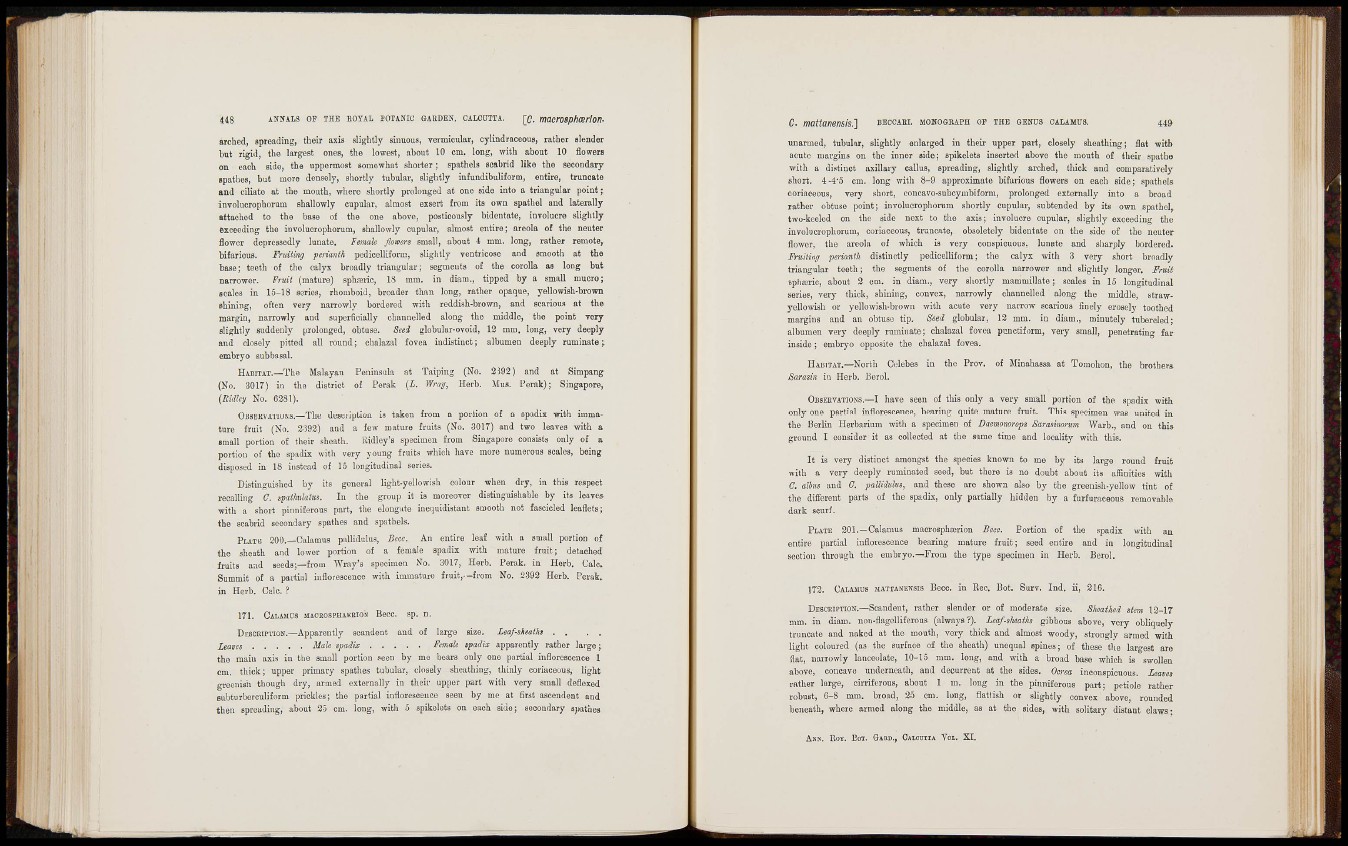
4 4 8 ANNALS OF THE HOYAL BOTANIO GAKDEN, CALCUTTA. [jj, macrosphcBrlonarched,
spreading, their axis slightly sinuous, vermicular, cylindraceous, rather slender
but rigid, the largest ones, the lowest, about 10 cm. long, with about 10 flowers
on each side, the uppermost somewhat shorter; spathels acabrid like the secondary
apathos, but more densely, shortly tubular, slightly infundibuliform, entire, truncate
and ciliato at the mouth, where shortly prolonged at one side into a triangular point;
involucrophorum shallowly cupular, almost exsert from its own spathol and laterally
attached to the base of the one above, posticously bidoiitate, involucre slightly
exceeding the involuorophorum, shallowly cupular, almost entire; areola of the neuter
flower depressedly lunate. Female flowers small, about 4 mm. long, rather remote,
bifarious. Fruiting perianth podicelliform, slightly ventricose and smooth at the
base; teeth of tho calyx broadly triangular; segments of the corolla aa long but
narrower. Fndi (mature) sphsric, 18 mm. in diam., tipped by a small mucro;
scales in 15-18 series, rhomboid, broader than long, rather opaque, yellowish-brown
shining, often very narrowly bordered with reddish-brown, and scarious at the
margin, narrowly and superficially channelled along tho middle, the point very
slightly suddenly prolonged, obtuse. Seei globular-ovoid, 13 mm. long, very deeply
and closely pitted all round; chalazal fovea indistinct; albumen deeply ruminate;,
embryo subbasal.
HABITAT.—The Malayan Peninsula at Taiping {No. 2J92) and at Simpang
(No. 3017) in thf) district of Perak {L. Wray, Herb. Mus. Perak); Singapore,
{Ridley No. 6281).
OBSERVATIONS.—The description is taken from a portion of a spadix with immature
fruit (No. 2392) and a few mature fruits (No. 3017) and two leaves with a
small portion of their shcatk. Ridley's specimen from Singapore consists only of a
portion of the spadix with very young fruits which have more numerous scales, being
disposed in 18 instead of 15 longitudinal series.
Distinguished by its general light-yellowish colour when dry, in this respect
recalling C. apathulaius. In the group it is moreover distinguishable by its leaveswith
a short pinniferous part, the elongate inequidistant smooth not fascicled leaflets;
the scabrid secondary spathes and spathels.
PLATii 200.—Calamus pallidulus, Beaa. An entire leaf with a soiall portion of
the sheath and lower portion of a female spadix with mature fruit; detached
fruits and seeds;—from Wray's specimen No. 3017, Herb, Perak. in Ilorb. Calc.
Summit of a partial inflorescence with immatui-e fruit,—from No. 2392 Herb. Perak.
in Herb. Calc. ?
171. CALAMUS M4CR0SPHABBI0N Becc. sp. n.
DRSCRIPHON.—Apparently scandent and of large size. Leaf-skealks . . . .
Leaves Male spadix Fcrr,ale spadix apparently rather large;
the main axis in tlie small portion seen by me bears only one partial inflorescence 1
cm. thick; upper primary spathes tubular, closely sheathing, thinly coriacoous, light
greenish though dry, armed externally in their upper part with very small deflexed
subturberculiform prickles; the partial inflorescence seen by me at first ascendent and
then spreading, about 25 cm. long, with 5 spikelets on each aide; secondary spathes-
C- mattamnsis^ BECCABI. MONOGRAPH OF THE GENUS CALAMUS. 449-
unarmed, tubular, slightly enlarged in their upper part, closely sheathing; flat with
acute margins on the inner side; spikelets inserted above the mouth of their spathe
with a distinct axillary callus, spreading, slightly arched, thick and comparatively
short. 4-4'5 cm. long with 8 - 9 approximate bifarious flowers on each side; spathels
coriaceous, very .short, concavo-subcymbiform, prolonged externally into a broad
rather obtuse point; involucrophornm shortly cupular, subtended by its own spathel,
two-keeled on tho side next to the axis; involucre cupular, slightly exceeding the
involuorophorum, coriaceous, truncate, obsoletely bidentate on the side of the nouter
flower, the areola of which is very conspicuous, lunate and sharply bordered.
Fruiting -perianth distinctly pedicelliform ; the calyx with 3 very short broadly
triangular teeth ; the segments of tho corolla narrower and slightly longar. Fruit
sphajric, about 2 cm. in diam., very shortly mammillate ; scales in 15 longitudinal
series, very thick, shining, convex, narrowly cliannellod along the middle, strawyellowish
or yellowish-brown with acute very narrow scarious finely erosely toothed
margins and an obtuse tip. Sied globular, 12 mm. in diam., minutely tubercled;
albumen very deeply ruminate; chalazal fovea punctiform, very small, penetrating far
inside ; embryo opposite the chalazal fovea.
HABITAT.—North Cuh
Sarasin iu Herb. l:ierol.
the Prov. of at Tomohon, the brothers
OBSEEVATIONS,—I have seen of this only a very small portion of the spadix with
only one partial inflorescence, bearing quite mature fruit. This specimen was united in
the J^erlin Herbarium with a specimen of Daemonorops Sarasinorum Warb,, and on this
ground I consider it as collected at the same time and locality with this.
I t is very distinct amongst the species known to me by its large round fruit
with a very deeply ruminated seed, but there is no doubt about its affinities with
C. alhm and G. pallidulus, and these are shown also by the greenish-yoilow tint of
the different parts of the spadix, only partially hidden by a furfuraceous removable
dark scurf.
PLATE 201.—Calamus macroapha;rion Beee. Portion of the spadix with au
entire partial inflorescence bearing mature fruit; seed entire and in longitudinal
scction through the embryo,—From the type specimen in Herb. Berol.
172. CALAMDS MATXANEXSIS Becc. in Rec. Bot. Surv. Ind. ii, 216,
DESCRIPTION.—Scandent, rather slender or of moderate size. Sheathed stem 12-17
mm. in diam. non-flagelliferous (always?). Leaf-sheaths gibbous above, very obliquely
truncate and naked at the mouth, very thick and almost woody, strongly armed with
light coloured (as the surface of the sheath) unequal spines; of tiiese the largest are
flat, narrowly lanceolate, 10-15 mm. long, and with a broad base which is swollen
above, concavo underneath, and decurrent at the sides, Oorca inconspicuous. Leaves
rather large, cirrifcrous, about 1 m. long in the pinniferous part; petiole rather
robust, 6-8 mm. broad, 25 cm. long, flatfish or slightly convex above, rounded
beneath, where armed along the middle, as at the sides, with solitary distant claws;
ANN. EOY. DOT. QARD,, OAr.cuirA VOL. S I.